
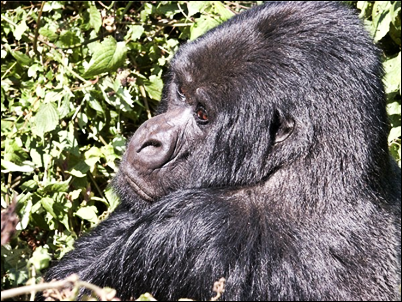
 The Mountain Gorillas
The Mountain Gorillas
Rwandese Volcanoes National Park (IUCN Biosphere Reserve, Uganda Bwindi Impenetrable
National park and the DRC’s parc national des Virungas (UNESCO World Heritage sites)
are home to the rarest of the great apes.
Mountain gorillas have slow rate of reproduction. Female give birth for the first time
at about age of 10 and will have more offspring every three of four years. A male reaches
sexual maturity at between 12 and 15 years, when he is in charge of his own Group. Able
to conceive for only about three days each month, the female produces a single young and
in rare cases twins (Happened in 2006 in SUSA Group found on the Rwandan side of the virungas –
Twins were born and they survived until present day).
The gorilla is shy and retiring rather than ferocious. It usually seeks no trouble unless
harassed. However, the dominant male will valiantly defend his family group is threatened.
Family groups are close-knit and may have up to 30 members but, even if smaller, the group
usually consists of at least one older male, one or more females and a few Juveniles.
Gorillas have strong attachments to members of their own group. Even when Groups meet and
mingle, and then subsequently part, each animal tends to remain with its respective unit.
The Silverback (Adult male gorilla), named for the silvery grey hairs on its back, normally
leads the group, serving as its chief protector and defender.
That Mountain Gorillas survive today is largely thanks to Dian Fossey, who is buried at her
research centre in the Virungas alongside the animals to which she dedicated her life. Fossey
became a household name following the release of the film “Gorillas in the mist”. Critical and
public acclaim ensure that Gorillas in the mist also served as international awareness of the
plight of Mountain Gorillas.
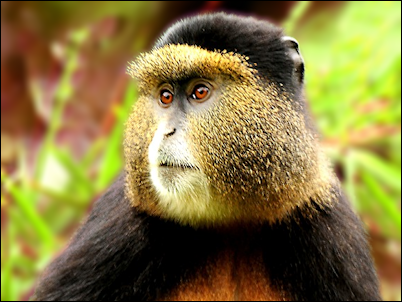
 Golden Monkeys
Golden Monkeys
Golden Monkeys a subspecies of blue monkey found only in the bamboo forests of the volcanic
mountain chain that forms a part of the boundary between Rwanda, Uganda, and DRC. It is an unique
experience that anyone planning to trek gorillas in Rwanda and Uganda should consider.
The golden monkey (Cercopithecus mitis kandti) weighs 10-25 pounds and has a golden body, cheeks
and tail with contrasting black limbs, crown and tail-end. Little is presently known about the
ecological requirements of the golden monkey, and the subspecies population numbers have never
been determined. Sharing the lofty montane forests of the Virungas with its great ape relatives
the mountain Gorillas they are an endangered species in Volcanoes National Park like the mountain
gorillas.
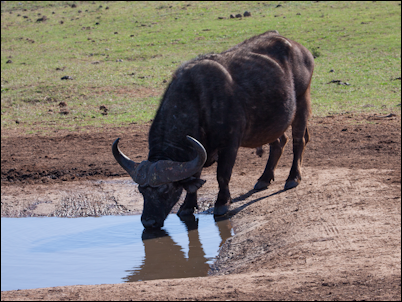
 Akagera Game Park
Akagera Game Park
Akagera comes as an exciting surprise after the steep cultivated hills and breezy climate that
characterize the rest of the country. Set a relatively low altitude along the Tanzania border,
this beautiful game reserve protects an archetypal African Savannah landscape of tangled Acacia
bush, interspersed with patches of open grassland and a dozen swamp-fringed lakes that follow the
meandering course of the Akagera River.
Akagera stirring and varied scenery is a complemented by a superb range of big game. Herds of
Elephant and Buffalo are most likely to be encountered when they emerge from the dense woodland
to drink at the lakes, while lucky visitors might stumble across a Lion, a Leopard or a spotted
Hyena. Giraffe and Zebra are frequently seen in open woodland, and more dozen types of Antelopes
habit the park. The game in the park is recovering after year of poaching and human presence.
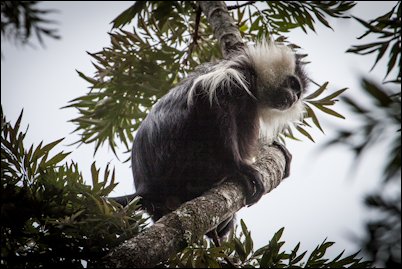
 Nyungwe Forest Reserve
Nyungwe Forest Reserve
This massive montane forest, in the southern Rwanda, the largest in Central Africa. It was established
as an ecotourism project that allows limited access to one of the largest tracts of montane rainforest
in Africa and the in-depth study of forest ecology undisturbed by agriculture or other human developments.
There are over of pristine hiking trails in the area that expose walkers to enormous hardwood stand,
numerous waterfalls, and an eye – boggling variety of other trees and insects (including some dazzling
species of Butterfly). With 275 species (24 of which are regional endemics), 13 primate varieties, and
mammals ranging from Leopards to forest Pigs, the Nyungwe Forest Reserve is a prime example of the wonders
of the African forest. The main attraction of Nyungwe is the proliferation of black- and – white colobus
Monkeys. The mammals wander around in the huge troupes, some of which are made of over 300 agile individuals.
Other primates likely to be encountered are L’Hoest’s monkey, silver monkey, vervet monkey, Olive baboon,
blue monkey, golden monkey, grey-cheecked mangabey, red-tailed monkey and chimpanzee, subspecies of black
and white colobus monkey. In addition to a variety of butterflies and Orchids, over 275 species of birds
have been recorded. Some over 250 species of trees and shrubs grow to over 165 feet (50m) in height.
Hiking is quite difficult in Nyungwe as it is an incredibly mountainous reserve with a variety of habitats
including wetlands, forested valleys and bamboo zones. Elevation ranges from 5250 to 9680 feet. The vegetation
at Nyungwe is very thick and many slopes are incredibly steep, if not impossible to ascend, so unfortunately
colobus and the other primates may be difficult to approach closely, and those such as a Chimpanzee who are
extremely agile difficult to follow.
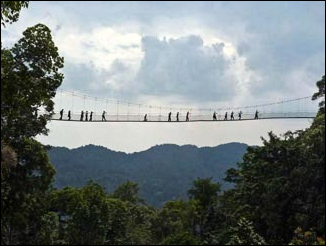
 Canopy Walkway
Canopy Walkway
The Canopy Walkway which has been completed in the Nyungwe Forest National Park is 50 meters above the
ground level, and 200 meters long. This impressive walkway with its three towers is the biggest in East
Africa.
The hanging platform which allows tourists to view different animal species in Nyungwe forest spreads
over hundreds of square meters and will allow tourists to be at the "eye-to-eye level" with different
primate species, and many bird species, all of which are fond of inhabiting the upper scales of the forest.

 The Lakes
The Lakes
Lake Kivu is extraordinary beautiful: a vast inland sea enclosed by the steep, green terraced hills that
are so characterized of rural Rwanda. Along its shores lie three resort towns, Rubavu , Huye and Rusizi,
connected by a wild roller- coaster road that tumbles through lush plantation field and relic patches of
misty rainforest to offer sweeping views over the shimmering lake.
Lake Kivu is the largest of numerous lakes which fills the valleys of Rwanda lakes BULERA & RUHONDO, close
to the gorilla –tracking centre of Musanze, are often neglected gems: deep blue waters ringed by steep hills
and tall waterfalls, with outlines of nearby Virunga volcanoes providing a spectacular backdrop.
|
|
|

